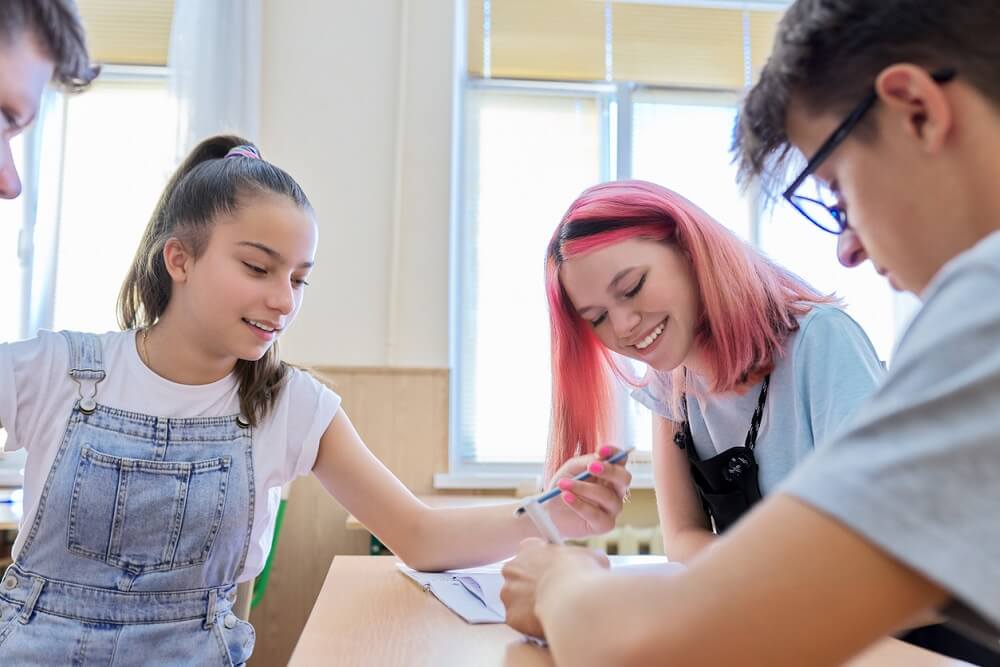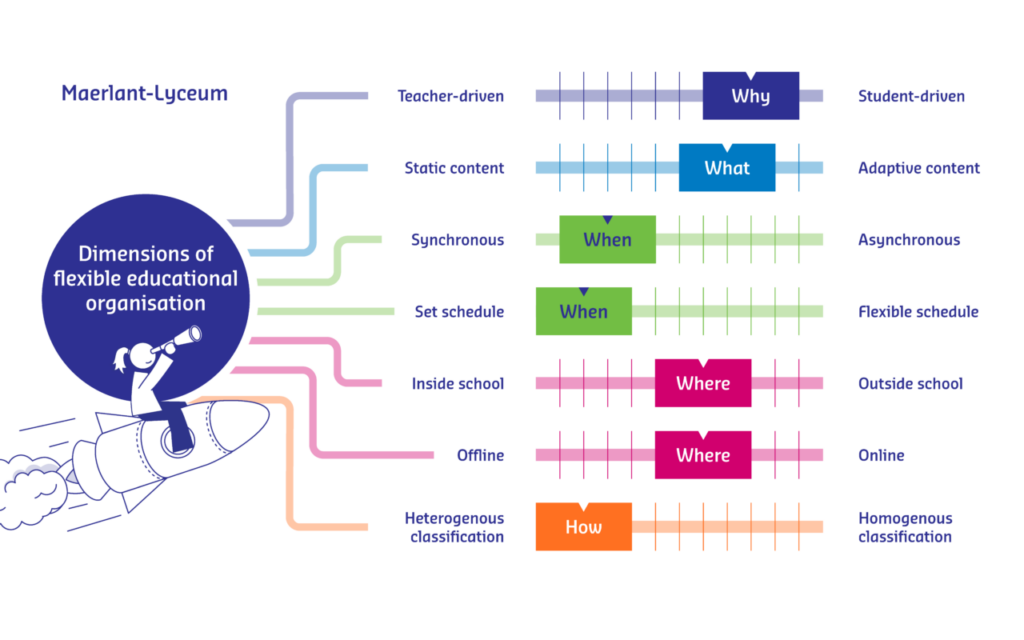- Beleid en organisatie
Maerlant-Lyceum uses ICT to deploy methods such as peer review
In pursuit of educational innovation, the Maerlant-Lyceum (HAVO-VWO) in The Hague has started using ICT. Formative learning, or giving students ownership of their own education, is reflected in methods such as peer feedback and tools like Leerlingbespreking.nl, De Verbonden School and Qompas. “I find that these types of platforms fit very well with our students' mindsets,” says rector Rebecca van den Berg. She therefore gives teachers like Marieke Elske Prins, who advocated the use of PeerScholar, plenty of room to experiment.


Door Astrid Buijs, Muriël Kleisterlee

In pursuit of educational innovation, the Maerlant-Lyceum (HAVO-VWO) in The Hague has started using ICT. Formative learning, or giving students ownership of their own education, is reflected in methods such as peer feedback and tools like Leerlingbespreking.nl, De Verbonden School and Qompas. “I find that these types of platforms fit very well with our students’ mindsets,” says rector Rebecca van den Berg. She therefore gives teachers like Marieke Elske Prins, who advocated the use of PeerScholar, plenty of room to experiment.
When principal Rebecca van den Berg (then vice-principal) heard about peer feedback from one of her teachers who had become enthusiastic about it during a study day, she immediately knew it was something for her school. “Teaching students to give and receive feedback is very much part of our educational process. That’s also why we launched Leerlingbespreking.nl, a tool to monitor student progress, a year and a half ago. A year after our study day, we had another meeting about the PeerScholar tool to hear about what it could do. By combining student accountability with ICT as a tool, you have something great on your hands. That is something we want to stimulate as a school.”
The school team’s most enthusiastic member was Marieke Elske Prins*, history and social studies teacher and coordinator for the National Education Programme (NPO). Together with section mate Michiel van der Heide, who marketed the concept De Verbonden School (The Connected School), they were the forerunners in using the PeerScholar tool in their classes. “Cultivating ownership among students is important to us,” says Prins. “Some students are increasingly difficult to motivate, but you do want to be able to send them into the future as independent citizens. I was already engaged in peer feedback before I attended that study day. There was still paperwork being exchanged. I thought that there had to be an easier way.”
Peer review and self-regulation
Prins knew she had found what she was looking for when she heard Bob Hofman, Learning Innovator & Consultant at ICT&E, talk about PeerScholar. “I wanted to use it to have students work on a media project in the context of media literacy. I created an assignment for that. When I showed this to my colleagues in the department, they got excited as well. The school board bought a license for the whole school, as it fitted in nicely with our school plan’s ambition to give students more control over their work and guide students better by paying more attention to feedback.”Van der Heide adds: “It is all about self-regulation. In other words, how do I go about motivating myself? How do I make a deal with myself? How do I reward myself if I succeed in taking those steps?”
Prins was already working to get students more involved in their own educational process. “Students often ask: why is this right or why is this wrong? We are very keen on emphasising the good – what you doing well and what can you improve on. But I am not the only one who can give feedback, they are perfectly capable of doing that themselves. So why shouldn’t they get points for that? If they give a presentation themselves and are able to explain course material to fellow students, they might master the material even better than if I merely relay it to them. I was still looking for a tool for writing reports. PeerScholar meets that need.”
Initially, PeerScholar offered only the possibility for students to complete individual assignments. So Prins contacted the tool’s Canadian developers. She also wanted students to be able to work on group assignments and apply peer review. Three-quarters of a year later, the developers had built in that functionality at her request.
Triangle dialogue using Student Assessment
One way of giving students more ownership of their own learning process is the Leerlingbespreking.nl tool. Van den Berg: “This is a kind of traffic light method. Green: you are doing well. Orange: these are your focus points. Red means: pay attention, you need to change something here. The system has two advantages. The one advantage is that teachers are prompted to give feedback on a person’s learning process and cannot simply say in a meeting: ‘That boy belongs at HAVO level.’ So you really have to give feedback in a constructive way that helps students move forward. Another advantage is that based on that feedback, students have to make their own plan to improve in certain areas.”
Prins adds: “Parent-teacher nights have been replaced by feedback triangles between the student, mentor and parents. These take place twice a year. Students have to link concrete actions to digital feedback. And in the feedback triangle, as a mentor, you ask questions about things on which the student is not yet specific enough. Is this perhaps motivation? Where does that come from? We take much more of a back seat and only ask follow-up questions. The student then tries to clarify what agreements they want to make with themselves, with teachers and with their parents. That is then what we’ll focus on that in the subsequent period. Most colleagues report that students are now much more aware of what they want and what they can improve. The conversations are also much more constructive, so it definitely adds value.”
Corona accelerates digitalisation
Bringing the rest of the teaching team on board in using these kinds of tools obviously doesn’t happen overnight. The corona crisis accelerated a number of things at the Maerlant-Lyceum. Prins: “Before corona, we all had our own laptops as teachers, but we didn’t use them much. Some departments did already work with Teams or other programmes. When the lockdown began, two school administration colleagues were given time to establish a structure: how will we communicate with one another, with students and with parents? How will we set up classes? After two or three days of no teaching, we were up and running again.”
Van der Heide was already developing education for dropped classes in core subjects, basic and study skills, among others, through instructional videos for students through his company De Verbonden School. At the school, this is employed in the event of dropped classes, allowing students’ learning to continue anyway. Prins: “[During the corona period] we also made instructional videos for fellow teachers to better handle digital resources. What was ideal was that our department was actually already working with PeerScholar during that period, so we could just continue our teaching as we were already doing it and only needed to expand the explanation videos, which Michiel was already working on. It also enables you to change your entire teaching repertoire just like that.”
Having students assess one another’s English reports
One of the colleagues they were also quick to enthuse about their ideas on peer feedback was English teacher Florine Roosken. She uses the method to prepare fifth-graders for the Cambridge C1 Advanced exam. “They have to do writing assignments and be able to distinguish different writing styles: essays, reports, proposals, letters and reviews. Some particularly interested students would ask me for feedback, but most just look at the grade and then throw their work in the bin. But the moment they are assessed by peers, they think: gee, I hadn’t thought of it that way, and they start thinking about their writing much more carefully. Then they have to improve their paper based on that anonymous feedback. And then you see that they pick up on things they might not have spotted otherwise.”
Learning to give feedback
If students are able to give constructive feedback, it partially counts towards the final grade Roosken gives them. Of course, Roosken did have to teach students how to give good feedback first. “Initially, they looked very closely at all spelling mistakes. But, of course, it is about much more: content. Have you done what the assignment asked, have you mastered the right writing style, are you using informal or formal language? Especially the students who were maybe not so good at the beginning, but who were willing to invest and learn; they grow and they really improve.”
Roosken has students from different groups give each other feedback. PeerScholar randomly pairs two peers with a student, so the student does not always receive feedback from the same person and is paired with another for each writing assignment. “Then I anonymously give a few examples of three good and three not-so-good reviews afterwards, and ask them to pick out the do’s and don’ts.” Students do not easily go overboard with feedback. “I have not yet experienced anyone really going over the top, and if so, as a teacher you say something about it. Or if someone shouts out: ‘Miss, look at what they did!’ Then I say: ‘Well, so this is an example of someone who has not understood how to give feedback.’ What is important, however, is that everyone sticks to deadlines. Because if someone fails to give feedback, someone else may be the victim of that negligence; they will receive feedback from only one peer instead of two. I also enter the dates in the Magister platform, so they always have a specific time to complete the so-called create phase, a period for the assess phase and a deadline for the reflect phase.”
Experimenting with new ways of working
Principal Van den Berg calls her school fairly traditional. “Teachers like structure, consistent behaviour and want to make sure students get the best out of themselves. At the same time, we have a very young teacher population, so the opportunity to experiment with new working methods or with more responsibility for students is fairly easy.”
One of Maerlant’s new focal points is student mentoring. “In the area of student mentoring, I see that despite various initiatives, students’ independence is still insufficient, while guidance or coaching for this also needs to be more extensive. Teachers in a mentoring or coaching role are thus given the space to do so. ICT tools like PeerScholar, Pupil Conversation and Qompas are very helpful in achieving our goals. Also because I believe students should develop themselves in this area as well. ICT is a means to an end. I find that these types of platforms fit very well with our students’ mindset; they are used to a traditional way of getting an education, but they need to grow in order to eventually thrive in society.”
Students at Maerlant tend to be somewhat more reticent than those following Dalton education, for example, according to Van den Berg. “They have more of a wait-and-see approach,but it helps when you use a more active platform. We started this transition several years ago. It is about starting small and getting more and more colleagues on board. You have to guide that process, which is where ICT really comes in handy.”
Giving space to pioneers while school management monitors the progress is Van den Berg’s strategy when it comes to innovating education. “For example, you can apply the PDCA cycle to it: Plan: what do we want to do? Do: how do we want to do it? Check: are things going as hoped? Act: are we adjusting course where necessary? All this must be established through open dialogue. I can spin you a great story, but the truth is: I still struggle with it too. I see a lot of great initiatives and would love to give everything a go, so sometimes you have to make hard choices. That’s the challenge for me. We are fine with what we have in terms of materials now. I am not going to also buy six different licences. Let’s first just streamline what we have and see how it sustains itself.”
* After the 2023 summer holidays, Marieke Elske Prins has made the switch to Leerlingbespreking.nl/Catwise after 11 years at Maerlant-Lyceum and started working as an education advisor.
Maerlant on the scale of the model of flexible organisation of education

Teacher-centred/student-centred – Prins: “We want to move more towards formative and thus student-centred teaching. That’s a change in your school culture and obviously takes time to work towards.”
Statistical content/adaptive content – Prins: “I think I personally do lean more towards adaptive, but that does not apply to the whole school yet. I adapt material I make myself anyway a bit every two years and we also make new instructional videos from time to time.”
Synchronous/asynchronous – Van den Berg: “Last year and this year, we sometimes had two set hours and one optional hour. What happens during that hour can be anything, what matters to me is the format; someone teaching you a certain subject for 50 minutes. A third optional hour seems like a good idea. Synchronous with a twist, so to speak – seeking the asynchronous by doing a project, setting an enriching task or collaborating whenever possible.”
Fixed schedule/flexible schedule – Van den Berg: “My ambition is to make it more flexible than what it is now, but the current workforce makes that a bit difficult. Our school is facing staff shortages as well as any other. I sometimes think: wouldn’t we solve a lot of problems if we were a bit more creative in our scheduling? However, I don’t know yet exactly what that would look like.”
Inside school/outside school – Van den Berg: “For now, we are focusing more on inside teaching than outside teaching. We do however have the potential to offer extracurricular activities such as robotics through schedule clearance.”
Prins: “Through de Verbonden School, students also have access to instructional videos at home.”
Offline/online – Van den Berg: “An online teaching resource would be good, but it takes a lot of man hours to keep it up to date. De Verbonden School also contributes to online learning, but students do not always see it as a mandatory part of the programme and are then more likely to slack up on it, which puts pressure on the whole thing. It is a process, so in that respect we are not there yet. I do think we are shifting more and more to online, if only due to the digital development of teaching methods.”
Heterogeneous classification/homogeneous classification – Van den Berg: “We have experimented with offering students both HAVO and VWO level subjects, but that makes a lot of things difficult to organise. So within the possibilities of the school’s organisation, I aim to be as heterogeneous as possible. That’s what I’m steering towards. For instance, in the second grade, we have an extended foundation year, delaying the decision for the level you end up in for as long as possible.”